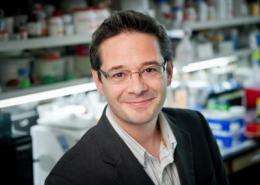Scientists develop new genomics-based approach to understand origin of cancer subgroups

Scientists have long recognized that cancers may look the same under the microscope, but carry different mutations, respond differently to treatment and result in vastly different outcomes for patients. An international team led by St. Jude Children's Research Hospital scientists has developed a new approach that uses genomic information from different species to understand the biology that drives the formation of these different cancer subtypes.
The approach was developed by studying a tumor called ependymoma that affects the brains and spines of children and adults, but may also translate to other forms of cancer. The research demonstrates for the first time that ependymomas in different regions of the nervous system arise when subtypes of stem cells found there acquire specific mutations. The research also led to discovery of the first gene, called EPHB2, proven to cause ependymoma and has created the first accurate laboratory model of this disease. The research was published today in the advance online publication of the prominent scientific journal Nature and is authored by Richard Gilbertson, M.D., Ph.D., a member of the St. Jude Departments of Developmental Neurobiology and Oncology.
"The approach we have developed provides a flexible way for scientists around the world to test the hypothesis that subsets of different cancers arise when particular mutations occur in particular cell types," Gilbertson said. "Because the laboratory models developed from this approach accurately model patient subgroups, they can then be used to develop and tailor effective new treatments for these patients."
The project builds on earlier work from Gilbertson's laboratory into the role that normal stem cells play in cancer. The body relies on stem cells, which can divide and take on more specialized functions, to keep organs repaired and operating smoothly. The research included scientists from seven institutions in the U.S., Canada and Great Britain.
For this study, investigators gathered 204 ependymomas from patients in the U.S., Canada and Europe to conduct the most comprehensive analysis yet of the ependymoma genome. Researchers found the pattern of DNA gain or loss differed depending on the ependymoma's location in the brain or spine and uncovered nine subtypes of the disease. The analysis also identified more than 200 genes as potentially important for triggering the tumor or helping the cancer spread. The list included EPHB2, a gene that regulates stem cell division and was recently linked to intestinal tumors. In this study, investigators linked EPHB2 to just one ependymoma subtype.
Researchers also tracked the different stem cell populations that give rise to ependymomas. Using an algorithm developed by Stanley Pounds, Ph.D., associate member in the St. Jude Department of Biostatistics, researchers compared patterns of gene expression in human ependymomas with gene expression in stem cells from different regions of the nervous systems of both embryonic and adult mice. The mathematical tool made it possible for the first time to compare global gene expression patterns between species.
The exercise linked one subtype of the human cancer with a particular subpopulation of mouse nervous system or neural stem cells. The stem cells also lacked the tumor suppressor genes Ink4a/Arf. When extra copies of EPHB2 were added to those neural stem cells and the cells were implanted in the forebrains of mice, half the mice developed brain tumors within 200 days. Scientists went on to show the tumors were identical to human ependymomas by several different measures. In contrast, no ependymomas developed when extra copies of EPHB2 were inserted into other subpopulations of mouse neural stem cells.
Additional testing found that the mouse ependymoma model matched just one subtype of human ependymomas but no other form of common human brain tumors.
















